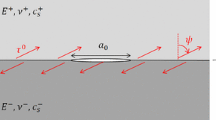Summary
Dynamic extension of cracks running along curvilinear interfaces of brittle bimaterials subjected to mechanical crack surface loads and superimposed thermal strains acting along the ligament is considered. This paper especially addresses the provision and discussion of elastodynamic interface parameters in order to assess quantitatively the bimaterial fracture in view of the governing physical features: applied mechanical and thermal strain loading, existence of an interface, crack-tip velocity and curvature of the interface contour. By utilizing the linear theory of thermoelasticity and adopting Stroh's method of generalized complex potentials, from the corresponding boundary and continuity conditions vectorial Hilbert problems are derived. It is shown that the parameters of the eigenvalues and of the eigenvectors of the Hilbert problems can be interpreted as elastodynamic interface mechanics parameters reading (β,v p, β Hf , μ Hf ). Generalized Dundurs parameters of dynamics (α, β) and consequently an associated generalized Dundurs diagram of dynamics are proposed. While the aforementioned elastodynamic interface parameters (α, β,v p, β Hf , μ Hf ) do not assume the interface to be damaged, interfaces with running interface cracks generally cause two additional interface parameters, denoted as bimaterial constants (ε, α Hf ), where the latter is specific to the curvature of the interface in conjunction with the velocity of the interface crack. However, the bimaterial constants (ε, α Hf ) can be traced back to interface parameters for an uncracked bimaterial, namely to (β, β Hf ).
Similar content being viewed by others
References
Achenbach, J. D.: Wave propagation in elastic solids. Amsterdam: North-Holland 1976.
Barnett, D. M., Lothe, M., Gavazza, S. D.: Considerations of the existence of interfacial (Stoneley) waves in bonded anisotropic elastic half-spaces. Proc. R. Soc. London Ser. A.402, 153–166 (1985).
Brown, E. J., Erdogan, F.: Thermal stresses in bonded materials containing cuts on the interface. Int. J. Eng. Sci.6, 517–529 (1968).
Dundurs, J.: Edge-bonded dissimilar orthogonal elastic wedges under normal and shear loading. J. Appl. Mech.36, 650–652 (1969).
Gao, H.: Stress analysis of holes in anisotropic elastic solids: conformal mapping and boundary perturbation. Q. Appl. Math.45, 553–572 (1992).
Herrmann, K. P., Noe, A.: Dynamic interface crack propagation and related problems of caustics. Arch. Mech.47, 915–956 (1995).
Hutchinson, J., Suo, Z.: Mixed-mode cracking in layered media. Adv. Appl. Mech.29, 64–191 (1991).
Lekhnitskii, S. G.: Elasticity theory of an anisotropic body. Moskau: Mir 1981.
Liu, C., Lambros, J., Rosakis, A. J.: Highly transient crack growth in a bimaterial interface: higher order asymptotic analysis and optical experiments. J. Mech. Phys. Solids41, 1887–1993 (1993).
Noe, A.: Zur dynamischen Ausbreitung gerader und gekrümmter Grenzflächenrisse in thermomechanisch belasteten Bimaterialien — Ein Beitrag zur Grenzflächenmechanik. Dissertation, Universität Paderborn 1994.
Noe, A., Herrmann, K. P.: Zur Grenzflächenmechanik bei schneller Rißausbreitung. ZAMM75, 237–238 (1995).
Noe, A., Herrmann, K. P.: Elastodynamische Grenzflächenparameter bei schneller Rißausbreitung. In: Bruchmechanik von Verbundwerkstoffen und Stoffverbunden. Arbeitskreis Bruchvorgänge der DVM27, pp. 373–382. Deutscher Verband für Materialforschung und- prüfung (DVM), Berlin 1995.
Rice, J. R.: Elastic fracture mechanics concepts for interfacial cracks. J. Appl. Mech.55, 98–103 (1988).
Stroh, A. N.: Steady state problems in anisotropic elasticity. J. Math. Phys.41, 77–103 (1962).
Suga, T., Elssner, G., Schmauder, S.: Composite parameters and the mechanical compatibility of material joints. J. Compos. Mater.22 917–934 (1988).
Suo, Z.: Singularities, interfaces and cracks in dissimilar anisotropic media. Proc. R. Soc. London Ser. A.427, 331–358 (1990).
Ting, T. C. T.: Explicit solution and invariance of the singularities at an interface crack in anisotropic composites. Int. J. Solids Struct.22, 965–983 (1986).
Ting, T. C. T.: Generalized Dundurs constants for anisotropic bimaterials. Int. J. Solids Struct.32, 483–500 (1995).
Tippur, H. V., Rosakis, A. J.: Quasi-static and dynamic crack growth along bimaterial interfaces: a note on crack-tip field measurements using coherent gradient sensing. Exp. Mech.31, 243–251 (1991).
Yang, W., Suo, Z., Shih, C. F.: Mechanics of dynamic debonding. Proc. R. Soc. London Ser. A433, 679–697 (1991).
Author information
Authors and Affiliations
Rights and permissions
About this article
Cite this article
Noe, A., Herrmann, K.P. Elastodynamic parameters for dynamic interface fracture mechanics. Acta Mechanica 123, 203–226 (1997). https://doi.org/10.1007/BF01178411
Received:
Issue Date:
DOI: https://doi.org/10.1007/BF01178411




